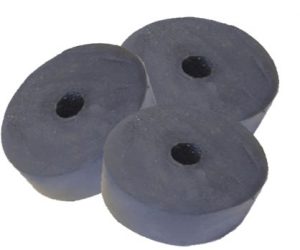
While small in size, rubber bumpers offer some big benefits. Countless workplaces rely on industrial machines to conduct their operations. From lathes and milling machines to grinding machines and planers, many of these industrial machines produce powerful vibrations. Rubber bumpers offer a solution by protecting machines such as these from damage.
The Basics of Rubber Bumpers
Also known as grommet bumpers, rubber bumpers are small pieces of rubber material that are designed to protect machines, equipment and other products from damage. They typically feature a circular shape, which may or may not have a small hole in the center. The presence of a hole allows a rubber bumper to deform when exposed to pressure.
Some rubber bumpers have adhesive on one side. To use them, you can press the self-adhesive side against a machine or piece of equipment. Even without adhesive, rubber bumpers can often be used under machines or equipment — or they can be used between doors or other components.
When to Use Rubber Bumpers
If your business’s workplace features industrial machines or equipment, you may want to use rubber bumpers to protect them from damage. Industrial machines and equipment often produce vibrations. When left unchecked, these vibrations can damage their respective components. Rubber bumpers can absorb these vibrations so that they don’t contribute to premature wear and tear of machines or equipment.
Rubber bumpers can also protect floors from damage caused by machines and equipment. Depending on the type of machine or equipment, you may be able to place a set of rubber bumpers underneath it. The rubber bumpers will act as a barrier between the machine or equipment and the floor. As a result, the machine or equipment won’t scratch or otherwise damage the floor.
How to Choose Rubber Bumpers
When choosing rubber bumpers, you should consider the size. Rubber bumpers are available in a wide range of sizes. Some of them are small, whereas others are large. Consider the machine or equipment with which you intend to use them, and choose rubber bumpers in an appropriate size.
Contrary to common belief, not all rubber bumpers are made of the same material. There are different types of rubber used in their construction. You can find rubber bumpers made of silicone rubber, for instance. Silicone rubber bumpers are elastic, resistant to moisture and long-lasting. There are also rubber bumpers made of nitrile rubber. Nitrile rubber bumpers are particularly effective for applications involving oil or grease. They are able to withstand these substances better than other types of rubber.
